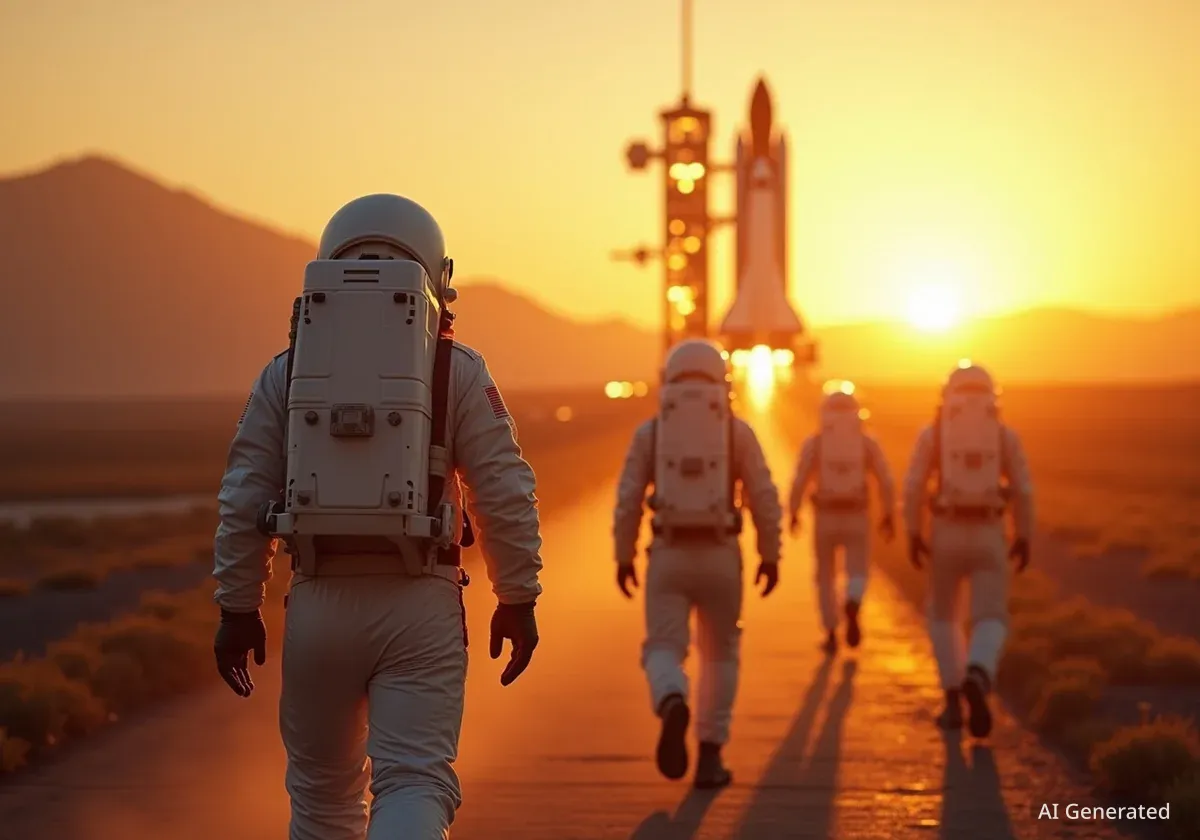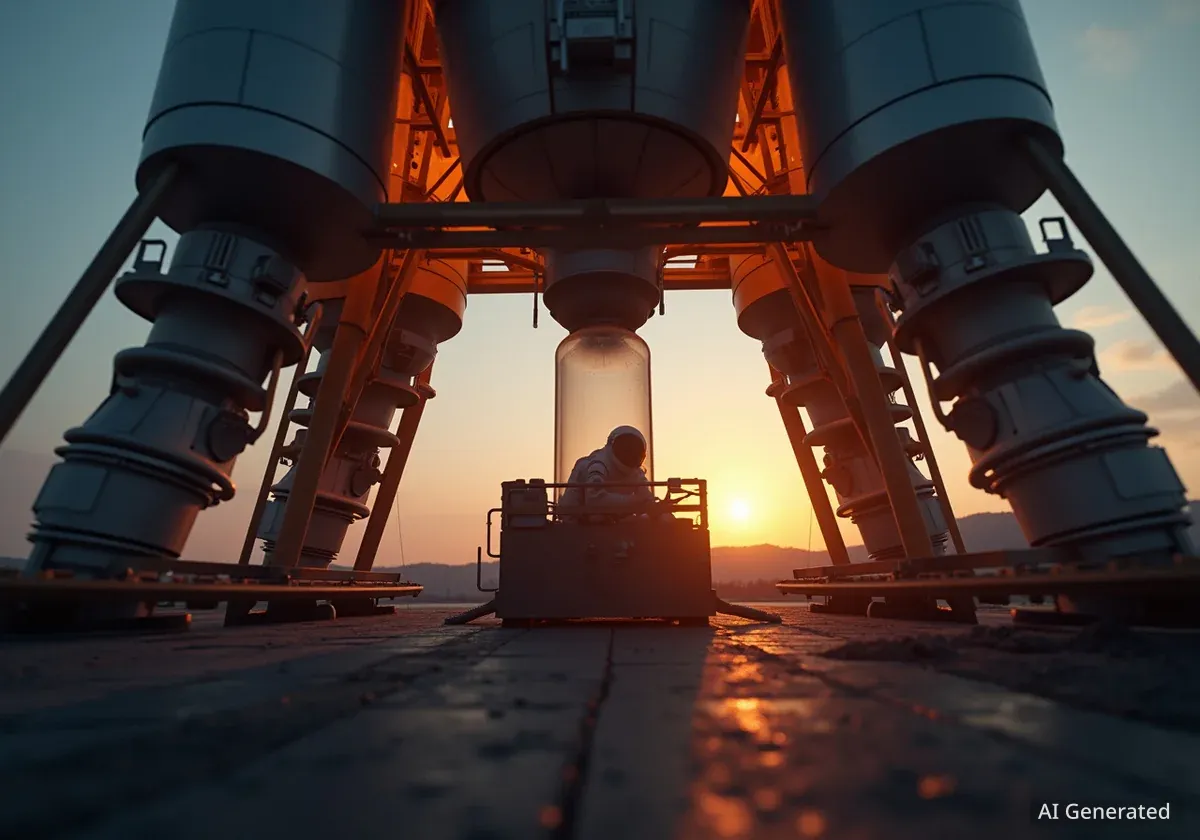The four astronauts selected for NASA's Artemis 2 mission are in the final stages of training for a historic 10-day flight that will take them around the moon. This will be the first time humans have traveled to the lunar vicinity in more than 50 years, serving as a critical test for future landings and deep-space exploration.
Key Takeaways
- The Artemis 2 mission is a 10-day test flight scheduled to circumnavigate the moon, marking the first crewed lunar journey since the Apollo program.
- The four-person international crew includes NASA astronauts Reid Wiseman, Victor Glover, Christina Koch, and Canadian Space Agency astronaut Jeremy Hansen.
- This mission will set a new record for the farthest humans have traveled from Earth, extending up to 14,500 kilometers beyond the moon.
- Artemis 2 is a foundational step for the Artemis program, which aims to establish a sustained human presence on the moon and prepare for future missions to Mars.
A Critical Test Flight
The primary objective of Artemis 2 is to test the capabilities of the Orion spacecraft and its life support systems with a human crew on board. While the mission's destination is the moon, Commander Reid Wiseman emphasized its nature as a rigorous evaluation of the hardware.
"We might go to the moon — that's where we want to go — but it is a test mission, and we are ready for every scenario," Wiseman stated during a press conference at NASA's Johnson Space Center in Houston. The crew will launch aboard the Space Launch System (SLS) rocket, the most powerful rocket ever built.
Paving the Way for Artemis 3
The success of Artemis 2 is essential for the progression of NASA's lunar ambitions. The data and experience gained from this 10-day flight will directly inform the planning and execution of Artemis 3, which is slated to be the first mission to land astronauts on the lunar surface, specifically near the south pole, since Apollo 17 in 1972.
The mission has faced some delays. According to NASA, engineers are carefully analyzing the performance of the Orion spacecraft's heat shield during the uncrewed Artemis 1 flight in 2022. Ensuring the heat shield's integrity for crewed reentry is a top priority before launching Artemis 2. The current launch window is projected for late 2024 or early 2025.
The International Crew and Their Focus
The Artemis 2 crew represents a series of historic firsts for space exploration. The mission will be commanded by Reid Wiseman, with Victor Glover serving as pilot and Christina Koch and Jeremy Hansen as mission specialists. Glover will be the first person of color, Koch the first woman, and Hansen the first Canadian to travel on a lunar mission.
A Disciplined Mindset
Despite the historic significance, the crew remains focused on operational execution rather than personal milestones. Victor Glover explained that concentrating on the grander aspects of the mission can be a distraction from the critical tasks at hand.
"If we want to live up to the standards that we owe the American and Canadian [public] and humanity in general, we have to be able to focus and know what the next right thing is to do," Glover said. "I actually spend a lot of time clearing that out of my head so I can focus on my job."
Christina Koch shared a similar perspective, recounting a recent conversation with Apollo 13 astronaut Fred Haise. "He said, 'I heard you're going to beat our record.' It made me realize maybe he's paying attention to it more than we are," Koch noted. She emphasized that the real story is the collective effort to return to the moon and conduct 21st-century science.
Veteran Astronauts and a First-Time Flyer
- Christina Koch holds the record for the longest single spaceflight by a woman, with 328 days aboard the International Space Station (ISS).
- Victor Glover has 168 days of spaceflight experience from his time on the ISS.
- Reid Wiseman, a former chief astronaut for NASA, has spent 165 days in space.
- For Jeremy Hansen of the Canadian Space Agency, Artemis 2 will be his first journey into space.
Pushing the Boundaries of Human Exploration
The Artemis 2 flight path is designed to push the Orion spacecraft to its limits. The trajectory will take the crew farther from Earth than any human has ever been, potentially reaching a distance of 9,000 miles (14,500 kilometers) beyond the far side of the moon.
This will surpass the long-standing record set by the crew of Apollo 13 in 1970. The mission's scientific objectives include gathering data on how the human body adapts to the deep-space environment, which is crucial for planning long-duration missions to Mars.
The crew will not land on the moon but will perform a lunar flyby and return to Earth, a journey expected to last approximately 10 days. The Orion spacecraft for the mission was recently named "Integrity" by the crew, reflecting the values they believe are central to the endeavor.
A New Era in Space
The Artemis program is set against a backdrop of renewed international interest in lunar exploration. NASA Acting Administrator Sean Duffy has characterized the current environment as a "new space race," particularly with China's advancing lunar program.
However, the Artemis 2 crew members view their mission through a different lens. Jeremy Hansen emphasized the importance of collaboration and high standards. "That's how you win a space race, and that's just how you move our countries forward," he said. "More importantly, that's how you create an environment where you might encourage others to collaborate."
Victor Glover described the effort as a "relay race," where each mission builds upon the last. "We are going together, and our mission success is built on handing off, starting off with Artemis 3 — that sets up our country and our partners to go back to the surface of the moon," he concluded. This collaborative approach underscores the long-term vision of the Artemis program: to create a sustainable and international framework for human exploration of the solar system.





